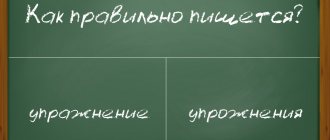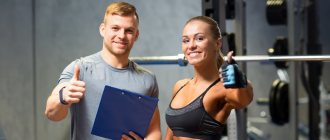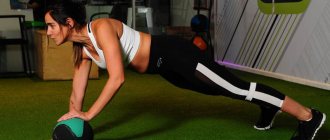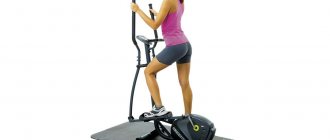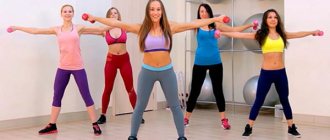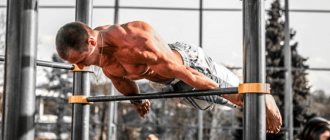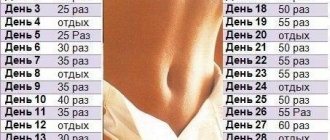Spelling a word
Among the most common variants of the analyzed word are:
- “Training” when the vowel “i” is written in the second syllable.
- “Training”, when the vowel letter “e” is indicated in the second syllable.
The only and correct option is the first one. It is a mistake to believe that the root of the word is the construction “coach”. The noun in question is verbal and comes from the infinitive “to train.” If the suffix “irova” is used in a verb, then in a noun it is transformed into “ir”.
It is worth remembering that there is no test word.
The noun "training" was borrowed from English and German words, so the correct spelling will just need to be remembered
Choosing the right instructor
As soon as you enter the gym for the first time, you will immediately see the instructors' gaze directed at you. Each instructor immediately sees a new girl who does not understand fitness, whom he can direct to the path of truth (victim).
From my personal experience: from the very beginning of my visits, I was lucky to meet, as it later turned out, a very competent instructor who taught me how to properly work on the machines and perform various exercises.
Then, over the course of a month, instructors passing by me casually told me that I was doing something wrong. Each of them commented on the execution of the exercise in his own way, saying that each other advised incorrectly.
To be honest, it was funny for me to watch all this, their tackles were similar to the wedding dances of peacocks, when each of them tries to convince me that he is better than others in the hope of getting payment from me for his services. This happens not only to me, the instructors also court other clients of the gym in a similar way, I constantly observe this.
Morphemic analysis of the word “training”
The noun in question is inanimate. It refers to the feminine gender in the singular of the first declension.
The root of the word “training” is the construction “tren”. The noun has three suffixes: “ir”, “ov”, “k”. The vowel letter “a” is the ending of the word.
Example sentences
To reinforce the correct spelling of a noun, let’s look at example sentences:
- Strength training is the key to successful weight loss.
- Cardio training can be done in the form of running over different distances or brisk walking.
- Any workout always begins with a warm-up, which should never be ignored so as not to damage the muscles and joints.
- Regular breathing training will help you hold it while underwater.
In each case, the noun in question is written with a vowel "i" in the second syllable.
Pay attention to the appearance of the fitness instructor
As a rule, girls immediately pay attention to a man’s appearance, and if you saw an instructor who, in your opinion, corresponds to the ideal type of man and immediately wanted him to become your instructor, immediately try to forget about this desire! Although if, in addition to an instructor, you are also looking to get a man, then forget about what I just said.
When the question arises of how to choose a fitness trainer, you should immediately pay special attention not to the appearance of the trainer himself (although this is also a significant factor), but to the bodies of the people with whom he is currently working out.
It is enough that the trainer has an athletic build (I must admit, it’s hard for me to imagine a fitness instructor with a beer belly. But for us, potential clients, the appearance of the trainer’s charges is still much more important.
Instructors - jocks are a good option, but there is one thing! As a rule, jocks work with men who build up their muscle mass, accordingly loading them with strength training as a priority. Of the girls under the tutelage of the muscle instructors, there are mostly girls with athletic bodies who clearly do strength exercises.
On the one hand, it’s slightly intimidating (how I’ll look compared to them), on the other hand, it’s attractive (these girls weren’t always like this). Also in the photo on their social media. networks, many of them have sports-type wives, and from my experience, such a trainer, at the very first conversation, suggested that I build up more muscle mass (judging by the shape of his wife, he likes pumped-up girls).
Instructors of standard body types also train people with different strength loads.
So when deciding how to choose a fitness instructor, you should not focus only on his figure. The appearance of an instructor is, of course, a visual sign of his competence, but it is far from the main indicator of his skill level. Sometimes it’s even the opposite - some powerlifter may not know how to work to burn fat. In my opinion, the appearance of a coach’s players is the surest sign by which to make a choice.
Which is correct: “to train” or “to train”?
Despite the fact that both options are often used in writing - “to train” and “to train”, it is worth remembering that the first option is erroneous. The verb in question is not formed from the word “trainer,” in which “er” is a suffix and not part of the root.
The verb "to train" comes from the English word "to train" and the German word "trainieren". There are no test nouns or verbs for it, so you just need to memorize the correct spelling.
Example sentences
You can consolidate and remember the correct spelling of the verb in question using specific examples:
- You need to exercise regularly, but not excessively, in order to prevent excessive fatigue of the body.
- Children need to practice swimming in a small pool.
- Exercising in the fresh air means providing yourself with energy for the whole day.
- To become a champion, you need to train hard every day.
- You need to train at full strength, and not carelessly. Otherwise, you won’t be able to achieve anything outstanding.
In each presented variant, the analyzed verb is written through the vowel letter “and” in the second syllable.
What a personal trainer should know
- The personal trainer should first of all ask about your goals for visiting the gym. Of course, most of us come to the gym (especially in the spring) driven by the goal of losing weight and toning our muscles. And the coach seems to understand this immediately. But every girl has her own nuances, and the coach must also understand this. We ourselves may not know what specific training goal we are pursuing, and the task of a qualified trainer, in my opinion, is to identify this goal together with us in the first lessons.
- The next logical and correct question from an experienced fitness trainer should be our level of training. My coach immediately asked me what kind of sport and how long I had been doing and if I had any idea about fitness. I am sure this is where the intensity of the training program should come from.
- Of course, a normal trainer will take an interest in your health. If there are any chronic diseases, diseases of the spine, joints or heart, there may have been some serious injuries. If any of these factors are present, the training program should be built taking these features into account.
- A competent instructor constantly reminds you to maintain correct posture. There is no verbosity in his comments with many different terms and scientific names for muscles and tendons, everything is simple, to the point and understandable.
- A professional always focuses on the correct seating level, the correct speed of exercise, etc.
- Also, a good instructor easily demonstrates the exercises himself. (And a cool man, amazingly handsome!!!). And he doesn’t look at how he will look in a room full of people.
- A competent instructor is constantly improving his knowledge and looking for new exercises.
- To all of the above, it is worth adding that the coach should be welcoming, responsive and friendly, and not look at you with a look like: “Are you stupid? How can you not understand how to do a reverse half-over? Arrogant instructors infuriate me because I think that if they are big and competent, then they are smarter than you.
Study, study and study again.
Many coaches are afraid of sports science and do not spend time studying it, but the range of knowledge required in subjects such as biomechanics, sports psychology, physiology, theory and training methods is very high. Of course, this is an incomplete list. Modern sport places expanded demands on a coach, and, as practice shows, it is now impossible to do without knowledge of traumatology, rehabilitation and other medical training.
A basic understanding of biomechanics will tell you whether a movement is correct or incorrect, how it relates to a standard technical template, and provide you with ways to maximize the effectiveness of the movement based on the individual athlete.
Sports psychology underlies motivation, confidence and anxiety management. At the moment this is one of the most promising areas in sports.
Sports physiology explains the body adaptations that occur as a result of the training process and gives you information to adjust your program. Due to this, you can achieve the best results and avoid injuries.
Training methodology will teach you to better provide information to your athletes so that they can master motor skills and learn proper technique as quickly as possible.
Training theory is what ties all other sports sciences together. It allows you to organize the correct training process to achieve maximum performance in a particular sport.
How much rest between sets and how long should the workout last?
I have already discussed both questions in a separate article. Here is an article about rest between approaches, and here is about how much you can train.
The duration of the workout should be no more than 1 hour, unless you are using pharmacological support (AAS). The fact is that training is a strong stress for the body and at a certain moment (usually after 45-60 minutes) the body begins to release cortisol (a hormone that destroys muscles), as well as other catabolic hormones and substances.
If the workout lasts too long, then you will delay the time of their release, as well as slow down the release of anabolic hormones that help us recover after training and grow muscles.
Rest between approaches should not be more than 1-1.5 minutes, because in this mode you can do a larger amount of work than if you rested for 3-5 minutes.
You are the main difference with powerlifting. The best muscle growth comes from high-volume work with medium weights, and strength growth comes from low-volume work with heavy weights.
In short, when creating your training program, you need to focus on approximately 90-120 seconds per approach (30 seconds per approach + 60-90 seconds rest). If your training lasts in this mode, then you will be able to “shove” a total of 30-40 approaches into it, which is the maximum limit. As a rule, a much smaller number of approaches is sufficient.
II. Decide on the number of workouts per week
The number of workouts is determined by your goal and your capabilities (availability of free time, money and energy). If you just want to keep fit, then 2 workouts a week is enough. If you want to increase mass and/or strength, then it is advisable to do at least 3 workouts (although I know cases where people grew well even with 2 workouts). Well, when losing weight or getting toned, there should be at least 3 workouts. And ideally 4 - 5.
But be that as it may, people, as a rule, are forced to rely on the availability of free time. Just don't deceive yourself. Soberly assess your capabilities and estimate how often you can visit the gym. After all, if you make a plan for 4 workouts a week, but only go 2-3 times, then you will have to redo the plan again.
Check your fitness trainer
Chatting with your coach in between sets, give him a mini-aptitude test - bring these five questions into the conversation:
Should I take sports nutrition/supplements? Correct answer: “No!” A good coach will not, under any circumstances, recommend something like that for at least the first six months. Very good - will never recommend anything other than regular multivitamins and omega-3 fats.
Will you show me our training program for the next month? Correct answer: “Yes, of course!” The main part of the work of a personal instructor is not to lead you from exercise to apparatus, but to plan future loads and analyze the work done. If he doesn't write anything down or plan his workouts ahead, that's a very bad sign.
Do you train yourself? Correct answer: “I exercise all the time, damn it!” A specialist who is truly passionate about his profession constantly works on himself, and exhaustively: before or after a 10-12-hour working day, when clients are not looking. This gives him additional energy for work and new methodological ideas, which he will be happy to share with you.
Can I chat with your other clients? Correct answer: “Of course!” The coach everyone is excited about will be only too happy to introduce you to all of them. Recommendations from former employers are also a point in his favor. If your interviewee is wary, he may not be able to show you even one of his fans.
What will I need for training? Correct answer: “Individual heart rate monitor” An experienced instructor has more than once revived his (or other people’s) visitors from fainting. You can lose consciousness not only through his fault, but also through your own fault: for example, if you don’t tell him about your nervous breakdown or your new diet. The trainer is not a telepath, but from the pulse monitor he will immediately understand what level of load you will handle today. If, after looking at the readings after the first two or three approaches, he sends you home, leave without making a sound.
Where to look for a coach?
Choose a fitness club. The least risky option is well-established establishments. Large chains value their reputation and conduct strict selection of employees. And good specialists themselves, as a rule, strive to work in reputable companies. If such clubs are out of your reach, go for reconnaissance in force - practice in different places, and at the same time talk with the girls in the locker room: regular visitors to the club can give a tip to a good pro.
Interrogate the administrator with passion. Firstly, don’t be shy to ask where your potential chosen one studied. The right to work as a coach is given by a diploma from a sports or medical university (the first option is preferable). Of course, “crust”, even with distinction, is not a sign of quality. But a coach without special education is just a pig in a poke. The most famous of the Moscow physical education universities are the Russian State University of Physical Culture, Sports, Youth and Tourism (GTSOLIFK), the Moscow State Academy of Physical Culture (MSAFK), and the Faculty of Physical Culture of the Moscow Pedagogical State University (MPGU).
In addition, if a club conducts regular training and certification of employees (independently or with the involvement of specialists from organizations such as the Pilates Institute, the Association of Fitness Professionals (FPA), the Federation of Fitness Aerobics of Russia (FFAR), its personnel are objectively higher in level than in others.
When you are offered a certain coach, ask how many years he has been in the profession. Practice shows that five years of work experience is the period during which a specialist usually manages to go through fire, copper pipes and the injuries of your predecessors. The main thing is that during this time he does not lose interest in his work. The advantage of a “green” trainer is his diligence and enthusiasm: those who are especially enthusiastic will compensate for their lack of experience with increased attention to you and your body. But keep in mind that for him you will be a guinea pig. Many clubs let newcomers into the gym with little to no preparation.
The coach has no right to score on you
Even if you have been working with a trainer for a long time, know the exercise technique and are well versed in the exercise equipment, your trainer does not have the right to “run off on business” while you are doing squats or go to the trainer’s room to fill out papers. If this happens once, you can forgive it, but if it happens with a certain frequency, it’s worth changing the gym or trainer.
A small note: the trainer should be nearby, so to speak, in your line of sight, but he is not obliged to run after you, wipe off sweat with a handkerchief and bring water.
Rate the coach at first sight
Appearance. As we know, it is deceptive. Therefore, if you get a handsome guy in excellent physical shape, pull yourself together and try to think soberly. Firstly, he is paid to attract clients - including with his unearthly beauty. Moreover, a pleasant appearance may be one of the conditions for hiring a trainer. Secondly, the model type can be the result of genetics, playing sports in “early youth” and, finally, even the abuse of illegal drugs.
Flexing muscles and a beaming smile is a pleasant sight, but a cheap argument. Better pay attention to what his clients look like. First lesson. First of all, the personal instructor should ask you in detail about your health status, previous injuries and training experience. Don’t be alarmed if the coach looks at your pupils, bags under your eyes or complexion, and asks you to measure your blood pressure. If he additionally tests you, for example, for flexibility, you have a rare find in every sense.
If at the very first training session an instructor pushes you through all the gym equipment to the point of exhaustion, it is unlikely that he understands what he is doing. You need to start with light exercises that will allow him to assess your strength and potential, and only then gradually increase the load. The same thing applies to the training program. Compiling it on the spot is an unaffordable luxury. A good pro will offer to work out for a week in any order, and only then write out a plan for further training.
Keep watching. It will be difficult to understand whether he is offering you the right loads and exercises. But here are two reasons for you to be wary. The first is a feeling of deja vu, as if you have been training according to the same scenario for an eternity. The second is the appearance of pain during exercise. If you feel something is wrong, consult with other instructors or a doctor.
